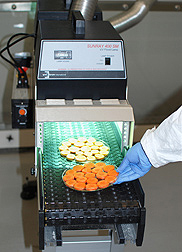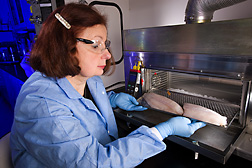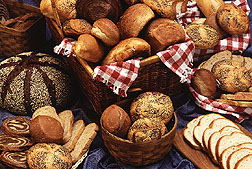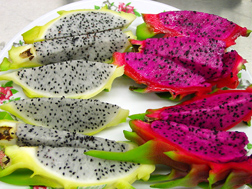This page has been archived and is being provided for reference purposes only. The page is no longer being updated, and therefore, links on the page may be invalid.
|
April 2011 |
|
|
Blueberries Help Fight Artery Hardening, Lab Animal Study IndicatesBlueberries may help fight atherosclerosis, also known as hardening of the arteries, according to results of a preliminary Agricultural Research Service (ARS)-funded study with laboratory mice. The research provides the first direct evidence that blueberries can help prevent harmful plaques or lesions, symptomatic of atherosclerosis, from increasing in size in arteries. Lesion size, measured at two sites in the aorta (the artery leading from the heart), was 39 and 58 percent less than that of lesions in mice whose diet did not contain blueberry powder. For details, contact: Xianli Wu, (501) 364-2813, ARS Arkansas Children's Nutrition Center, Little Rock, Ark. |
Got Fish? Nutrition Studies Explore Health BenefitsOngoing Agricultural Research Service (ARS) studies are helping uncover new details about how fish-oil components help protect us from chronic diseases. An 8-week test with 50 laboratory mice indicated that a specific omega-3 fatty acid from fish oil, called DHA (docosahexaenoic acid), protected the animals against two harmful side effects of a different fatty acid, CLA, found in some dietary supplements as trans-10, cis-12 CLA: CLA-induced insulin resistance and CLA-induced non-alcoholic fatty-liver disease. In contrast, another omega-3 fatty acid from fish oil, EPA (eicosapentaenoic acid), offered only partial protection against CLA-induced non-alcoholic fatty liver disease, and provided no protection against insulin resistance. In a literature review, the scientists indicate that findings reported in the past decade have been inconsistent in regard to the effects of EPA and DHA on insulin resistance in human volunteers. For details, contact: Darshan S. Kelley, 530-752-5138, Immunity and Disease Prevention Research Unit, ARS Western Human Nutrition Research Center, Davis, Calif. |
|
|
|
Ultraviolet Light Boosts Carrots' Antioxidant ValueExposing sliced carrots to UV-B, one of the three kinds of ultraviolet light in sunshine, can boost the antioxidant activity of the colorful veggie, based on results of preliminary studies by Agricultural Research Service (ARS) scientists. The carrot study results suggest that a moderate, 14-second dose of UV-B can boost fresh, sliced carrots' antioxidant capacity by about 3-fold. The dose is energy-efficient and does not significantly heat or dry the carrots. For details, contact: Tara McHugh, (510) 559-5864, Processed Foods Research Unit, ARS Western Regional Research Laboratory, Albany, Calif. |
Keeping In-Demand Smoked Salmon Safe to EatAgricultural Research Service (ARS) scientists are helping ensure that the smoked salmon that's always a hit at festive gatherings also is always safe to eat, including the development of a first-of-its-kind mathematical model that food processors and others can use to select the optimal combination of temperature and concentrations of salt and smoke compounds to reduce or eliminate microbial contamination of the product. The researchers determined that every 9 degree Fahrenheit increase in temperature resulted in a 10-fold increase in rates of inactivation of Listeria. They used this and other data from the study to create the mathematical model. For details, contact: Andy (Cheng-An) Hwang, (215) 233-6416, Residue Chemistry and Predictive Microbiology Unit, ARS Eastern Regional Research Center, Wyndmoor, Pa. |
|
|
|
Tactics to Safeguard Catfish and Tilapia Fillets from Foodborne Pathogens Explored
For details, contact: Kathleen Rajkowski, (215) 233-6440, Food Safety and Intervention Technologies Unit, ARS Eastern Regional Research Center, Wyndmoor, Pa. |
Scientists Produce Palatable Gluten-Free BreadBy removing a certain amount of fat from a corn protein called zein, Agricultural Research Service (ARS) scientists have been able to produce high-quality gluten-free bread dough more similar to wheat dough, as well as free-standing, hearth-type rolls that resemble wheat rolls. Millions of Americans affected by celiac disease are unable to digest gluten, a protein in flour from grains such as wheat, barley and rye. The researchers previously had made gluten-free pan bread from other grains, but they couldn't make free-standing rolls because the dough spread out too much.For details, contact: Scott Bean, (785) 776-2725, Grain Quality and Structure Research Unit, ARS Center for Grain & Animal Health Research, Manhattan, Kan. |
|
|
|
Tangerine Tomatoes Surpass Reds in Preliminary Lycopene StudyA one-month study led by Agricultural Research Service (ARS) scientists in California has provided new evidence to suggest that, ounce for ounce, tangerine heirloom tomatoes might be a better source of a powerful antioxidant called lycopene than are familiar red tomatoes. The difference lies in the forms of lycopene that the two tomato types provide. The trans-lycopene form, or isomer, makes up most of the lycopene in common red tomatoes. In contrast, most of the lycopene in tangerine tomatoes is tetra-cis-lycopene. For details, contact: Betty J. Burri, (530) 752-4748, Immunity and Disease Prevention Research Unit, ARS Western Human Nutrition Research Center, Davis, Calif. |
Successful Tech Transfer Leads to More Hawaiian ExportsHawaiian growers can now export more fruits and vegetables to the U.S. mainland, thanks to studies by Agricultural Research Service (ARS) scientists. Strict quarantine restrictions and phytosanitary measures have been in place to ensure agricultural pests like fruit flies don't invade the mainland along with imports from Hawaii like papaya, rambutan, longan, dragon fruit and purple-fleshed sweet potato. The ARS scientists found that a generic dose of 150 grays (Gy) of radiation is suitable for controlling the three species of Tephritid fruit flies found in Hawaii. They also demonstrated that a generic dose of 400 Gy is broadly effective against many other pests. These results contributed to approval by USDA's Animal and Plant Health Inspection Service (APHIS) of using generic doses of radiation for treatment of Hawaiian produce. The ARS scientists also examined product quality after irradiation. Those tests helped establish the maximum dose levels the fruit and vegetables could withstand while ensuring consumers receive a high-quality product. For details, contact: Peter A. Follett, (808) 959-4303, Tropical Crop and Commodity Protection Unit, ARS U.S. Pacific Basin Agricultural Research Center, Hilo, Hawaii. |
|
|
|
Scientists Release First Cultivated 'Ôhelo Berry for HawaiiThe first cultivar of 'ôhelo berry, a popular native Hawaiian fruit, has been released by Agricultural Research Service (ARS) scientists and their university and industry cooperators. 'Ôhelo (Vaccinium reticulatum Smith) is a small, native Hawaiian shrub in the cranberry family, commonly found at high elevations on the islands of Maui and Hawaii. As people scour the landscape to harvest this wild, delectable berry for use in jam, jelly and pie filling, they unfortunately disrupt the fragile habitats where this plant grows. The ARS scientists are now evaluating 'ôhelo for small farm production and ornamental use. For details, contact: Francis Tso Ping Zee, (808) 959-5833, ARS Tropical Plant Genetic Resources and Disease Research Unit, Hilo, Hawaii |











